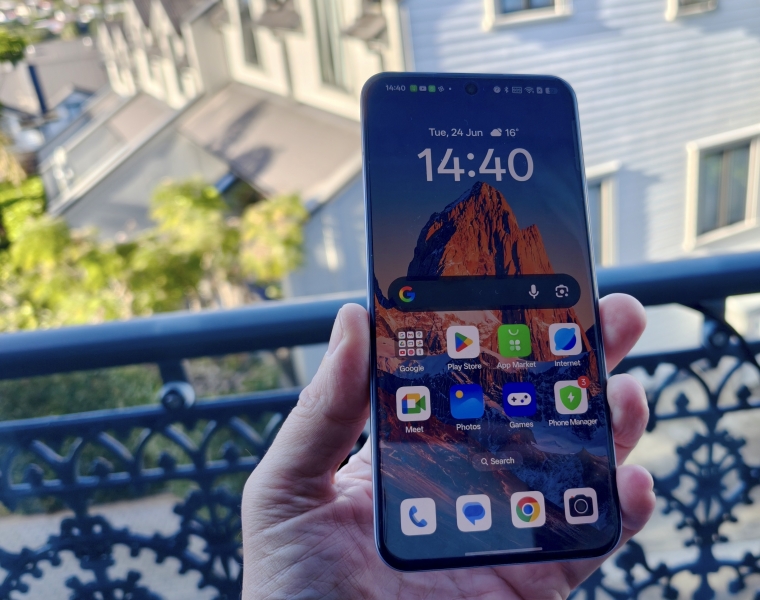
Chinese smartphone vendor Oppo has updated its Reno13 range, which sits below the Find premium models, with three devices: the $699 Reno13 F, the $849 Reno13, and the $1399 Reno13 Pro.
We’ve had the latter device for a while, and it seems Oppo was thinking “premium lite” rather than “mid-range” with the Reno13 Pro: it does a range of things very well, but the price has jumped this year, and the phone has a few misses.
First impressions out of the box are great. The Reno13 Pro is nicely built, using Corning Gorilla Glass 7i which Oppo seems to be first with. Fingerprint and facial recognition scanners are built-in; both are fast and accurate to use. Very premium stuff, all that.

There’s 5G of course, and the Reno13 Pro uses eSIMs and physical ones; Wi-Fi 6E is supported, but not the latest Wi-Fi 7; the latter is a nice go-faster feature when you hotspot off phones.
The AMOLED screen is pretty good with 1280 by 2800 pixel resolution, HDR10+/10-bit colour for over a billion hues, and up to 120 Hertz refresh rate for smooth scrolling and animations.
However, you have to turn all that on in the phone settings, as the Reno13 Pro defaults to 1080 by 2374 pixels, and an unspecified “optimal” refresh rate.
Enabling full resolution and high refresh rate eats into battery life and Oppo warns the device can heat up. Even though you set the refresh rate to a high 120 Hz, you might need to check what the app you’re using is set to (it can be 60, 90 and 120 Hz). It's a little too complicated, that.
You get a chunky 87 Watt charger (USB-A to USB-C cable) with the Reno13 Pro for fast, 80 Watt charging. However, possibly to keep the price down, global models of the Reno13 Pro don’t have wireless AirVOOC charging that Chinese devices come with.
This is going to sound very first-world-problem-ish, but being able to charge the phone by putting it on a pad, no cable required, is one of those features that’s annoying to live without.
With a battery rated at 5640 milliampere hours, the Reno13 Pro lasts a long time between charges though. The energy-efficient MediaTek Dimensity 8350 chipset that runs the phone is not the fastest in the business: the Reno13 Pro put in OK-ish scores in performance benchmarks, but at this price point, there are quicker phones out there.
You get plenty of memory - 12 gigabytes - and storage: 512 GB UFS 3.1 with the Reno13 Pro; the amounts unchanged compared to last year’s Reno12 Pro though.
Two good cameras, one so-and-so
At the back of the Reno13 Pro there are two chunky camera lenses. They both house 50 megapixel sensors; in the case of the main camera, it’s a Sony IMX890 1/1.56” sensor, which is often found in premium devices.
This is backed up by another 50 Mpixel telephoto lens, with 3.5 times magnification. Those two cameras are very good, and have bells and whistles like optical image stabilisation; the camera app in the Reno13 Pro has a Pro mode as well, with manual exposure parameter settings.

The fancy Hasselblad tuning that the $1999 Oppo Find X8 Pro has didn’t make it to the Reno13 Pro but you get the ProXDR extended dynamic range feature which provides great colour rendering, and Sound Focus for directed audio recording.

For the ultra-wide camera, the Reno13 Pro uses an 8 Mpixel unit which isn’t as good as the other two imagers. It does have autofocus though.
More effort was put into the front camera, which sees the world through a punch hole in the display, at 50 Mpixel resolution, and with autofocus. You can take 50 Mpixel pics with the front and the two hi-res rear cameras, but it doesn’t add much; better to let the Reno13 Pro do its thing with 12 Mpixel down sampled photos that let you use camera features like the triple-level zoom for the front shooter.
Video can be shot up to 4K resolution, and 60 frames per second. Again, the quality is pretty good if you stick to the main camera; the telephoto one is OK too. For the ultrawide camera, the max resolution is 1080p at 30 fps.
There’s a special underwater photo and video mode because the Reno13 Pro is IP69 rated. Oppo suggests that as long as you’re careful, the phone will survive water two metres deep, for 30 minutes.
The phone switches off screen control for the camera in underwater mode, and you use the volume and power buttons instead. Video is shot at 1080p, 30 frames per second, and photos at the usual 12 Mpixel resolution. That’s only with the rear cameras, and underwater selfie-fiends are out of luck here, sorry.
When you’re done, hold the power button to exit underwater mode, ejecting water from the ports with sound vibrations in the process.
It was too cold during the review period to try out the underwater mode, and before diving into the water, I’d want some way to secure the phone about me with a wrist strap or similar.
Android 15 with ColorOS customisation, and AI features
The Reno13 Pro runs Android 15, with Oppo’s ColorOS customisations. It’s a nice and clean Android variant, and Oppo is pretty good at updating the operating system so you get the required security patches and new features.
Five years worth of updates are included from Oppo for the Reno13 Pro. That’s two years less than for new Samsung devices, and Apple keeps its phones updated for six years.
And yes, there are artificial intelligence (AI) features in ColorOS: the Google Gemini 2.5 Flash and Pro chatbots with usage limits unless you pay $36.99 a month to upgrade, and the operating system itself has AI everywhere.
The Trinity Engine uses AI to keep the phone optimised, and there are GenAI tools for writing, summarising, reading out screen content, and transcribing audio recordings.
A bundle of AI photo editing features to manipulate images, like erasing objects, removing reflections, and unblurring/clarifying them are also included. I found them a bit slow, like the AI Eraser which uploads images to Oppo’s servers for processing, and others that require model downloads for updating before they can be used.
Curiously, one popular AI feature, being able to click and copy just the subject of an image, or to remove the background, is missing from the AI editing suite.
Video editing is non-AI however, with just the basics, like trimming, cropping, filters and vlogging themes.
Although some AI features are useful to have, I don’t think we’re at the stage yet where the technology is a must-have in smartphones. By all means, fight me on that.
Value proposition
Although Oppo has positioned the Reno13 Pro as a mid-range device, the $1399 retail price is on the high side for the segment. It is $300 up on last year’s Reno12 Pro, and pushes the smartphone towards the premium end of the market.
Adding to that, Oppo recently released the Reno14 range overseas, with a newer MediaTek Dimensity processor, and 50 Mpixel ultra-wide camera instead of just 8 Mpixel; the Reno14 Pro model might even have wireless charging for global markets.
New Zealand is on a different release cadence with the Reno phones, an Oppo spokesperson said, so we’ll have version 13 for now.
The Reno13 Pro has great battery life, is well put together with a waterproof-ish case, plus you get good cameras, a big screen with high refresh rate and full gamut of colours.
But, that jump in price from last year is hard to overlook, particularly if there's a newer version of the device waiting in the wings that fixes the current Reno13 Pro's shortcomings.
2 Comments
The relentless pace of cell-phone releases is wearing, and the sheer variety of Android implementations from different makers that include various amounts of pointlessness, bloatware and surveillance is doubly so.
While I've finally caved and bought a Pixel phone, with the objective of setting it up on Graphene OS to de-Google it after I'm sure everything works, even this most clean of Android implementations requires much to be deleted, disabled or ignored while still not being able to exert real control over the way it works.
As a serious question: do you think consumers will ever be supported by regulation to take full charge of their devices without having to take extraordinary (and warranty voiding) measures like rooting or OS replacement?
As a serious question: do you think consumers will ever be supported by regulation to take full charge of their devices without having to take extraordinary (and warranty voiding) measures like rooting or OS replacement?
Not unless there are legal mechanisms that exempt vendors/device makers from various obligations under consumer protection legislation. If I understand you right, that is.

We welcome your comments below. If you are not already registered, please register to comment
Remember we welcome robust, respectful and insightful debate. We don't welcome abusive or defamatory comments and will de-register those repeatedly making such comments. Our current comment policy is here.